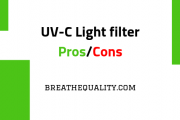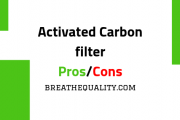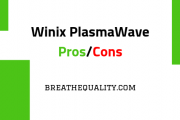After browsing for an air purifier, you suddenly found out that you couldn’t just choose a random air purifier and purchase it. You will notice that there are tons of air purifiers out there, with hundreds of air filter types. Don’t worry; in this guide, you will learn everything you need to know about air filter types.
Yes, we will give you everything!
Because there are only 4 basic types of air filter technology that these air purifier devices commonly use, you can easily check each one out.
Table of Contents
Air filter types are the first thing people search for before making any decision to buy an air purifier. Notice that we are giving instructions to the air filters used in the air purifiers, which are somehow like this.
*Notice: Before you are going to decide to buy anything, please first read our Breathe Quality’s air purifier buying guides in order to make your buying decision right. We don’t want you to waste money, honestly!
Air Purifier Definitions:
These four air purifying filters are used for difference types of indoor air pollution. We will explain exactly how each one works.
1, HEPA Air Filter
High-efficiency particulate arresting (HEPA) filters are the first and most well-known filters in air purifiers on the market today, making this air filtering process the highest standard for air purification. You will come across the four-letter term “HEPA” no matter how many times you search for an air purifier or a vacuum cleaner.
A HEPA Air Filter consists of:
- A highly dense paper filter that captures airborne toxic contaminants (like dust, mold, pollen, and even animal hair) and basically everything else that makes your air NOT CLEAN. This filter is degradable and must be replaced after 6 months to 1 year. High-end air purifiers mostly have a light notification for this routine replacement.
- A mesh HEPA pre-filter, which is only in the latest air purifiers. This filter will be marked as permanent HEPA because it is washable.
Because of its well-known fame, there are many filters using the HEPA acronym, which is confusing for anyone searching “air purifier” for the first time. The only certificate label you should trust is “True HEPA Filter.” A True HEPA filter is certified to remove 99.97% of all microscopic particles as small as 0.3 microns in size, which is the tiniest particle size to get into your lungs.
In order to carry the “True HEPA Filter” label, a product must meet strict standards set by the U.S. Department of Energy.
Other filters that use the terms “HEPA-type” or “HEPA-like” are inferior products to “True HEPA Filters.” These filters can only capture particles as small as 2–5 microns, which is more than a 600% decrease in efficiency. You may think that it is good enough. Please think again. Because there is no set standard for terms like this, you may find yourself using little to no air purifier for your home if you are not careful.
Expert tip: When shopping for a HEPA air purifier, look for the “True HEPA Filter” certification.
- Highly efficient, capture most of the toxic contaminants
- Trapped particles will stay within the air filter
- The physical air filter won’t emit ozone, which causes asthma and other breathing issues
- Requires routine filter replacement to maintain the efficiency
- Doesn’t remove odors and smell
2, Ionic Air Filter
Ionic Air Filter (which is also called Ionizer Purifier) is an air cleaning technology that operates with charged electrical surfaces or needles. It will emit a cloud of negatively charged ions into the air. Contaminants (which are positively charged ions) will be electrostatically attracted to a charged collector plate. For inferior products, these impurities are only forced to fall onto the floor and nearby surfaces. This process eliminates ultra-fine particles down to 0.1 microns in size.
This ionic air filter also produces trace amounts of ozone, with less than 0.05 ppm of ozone to comply with an industrial safety standard.
Expert tips: Some people have claimed that the ions it generates have caused an increase in their asthmatic symptoms.
However, only the best products have these features, for example, the Rabbit Air MinusA2 SPA-780.
- Maintenance free, without filter replacement
- Can even remove some bacteria and viruses
- Small amounts of ozone as a byproduct which can irritate asthma and respiratory issues
- Doesn’t remove odors and smell
- Higher power consumption
3, Activated Carbon Air Filter
An Activated Carbon filter (which many brands just call Charcoal air filter) uses a special form of activated carbon that consists of millions of tiny adsorbent pores. This Activated Carbon filter can adsorb and neutralize volatile chemicals on a molecular basis (for example, harmful gases, odors, VOCs, and some chemicals). This filtering process won’t remove contaminants; it will instead change them from the gaseous phase into the solid phase. That’s why this air filter type rarely stands alone but works in conjunction with other air filter types, mostly the HEPA air filter.
Expert tip: Although many high-end brands just focus on emphasizing True HEPA filters, they still have a charcoal layer like this.

These 4-layer filters above belong to the Coway AP-1512HH Mighty Air Purifier – one of the best air purifiers and an Amazon’s Choice for a long time.
Carbon filters are not used to remove particles that cause health issues, but rather to get rid of the ones that cause odors. These filters make a home smell fresh and clean.
- Can be reused
- The only air filter to remove chemicals, gases, odors and smells from pets, cooking, smoke, paints and cleaning supplies
- Needs other air filters
- Needs to be changed frequently
4, UV Light Air Filter
UV Light Air Filter (UV stands for Ultra Violet) is the most different air filter types from the 3 air filter types mentioned above. It will be easy for you to understand this air filter if we give you a definition of UV light.
UV light is part of the electromagnetic spectrum. It makes up all wavelengths of electromagnetic radiation, including light, radio waves, and x-rays, which are arranged according to frequency and wavelength.
UV light is a special type of radiation that can’t be seen by the naked eye because it is part of the invisible section that makes up the electromagnetic spectrum. To be precise, its wavelength is from 400 nm (750 THz) to 10 nm (30 PHz), shorter than that of visible light.
UV-C light in air purifiers is a powerful form of radiation that causes no harm to people. However, it is excellent at killing microorganisms, such as germs and viruses.
Summary: UV Light Air Filter Technology emits an invisible light (called Ultra Violet Light) that attacks pollutants (mostly germs and viruses). UV light is contained inside the air purifier and not released into the room. Also, the type of UV light (UV-C light) is harmless to humans.
After passing through all of the other filter types, the air passes through a small internal space that exposes the particles to UV light. An UV air purifier works by disrupting the core DNA of these germs and viruses. This process sterilizes them and prevents them from multiplying to make you sick.
However, to combat other contaminants like dust, mold, animal dander, etc., UV light air filters can’t stand alone and must combine with others.
Expert tip: Always check the air purifiers using the technology of UV-C light. This type is completely safe for humans and doesn’t cause any negative side effects.
- Can kill the microorganisms such as germs, bacteria and viruses
- The UV-C light cause no harm to humans
- Still produces ozone
- Needs to be changed frequently
- High Power consumption
- Can’t remove the actual particles from the air
List of the best air purifiers
- 1, Best Air Purifier (Air Purifier Ranking List)
- 2, Best Air Purifiers for Allergies
- 3, Best Air Purifiers for Bedroom
- 4, Best Air Purifiers for Baby
- 5, Best Air Purifiers for Smoke
- 6, Best Air Purifiers for Dust
- 7, Best Air Purifiers for Mold
- 8, Best Large Room Air Purifiers
- 9, Best Air Purifiers for Pets
- 10, Best Air Purifiers for Office
Rating Breathe Quality
-
Average ratings for this post



